Trends in quantum computing patents
by Elliott Mason, PhD
This article presents global quantum computing patent trends over the past decade. The data details patents and patent applications reported by patent offices worldwide with publication dates since 2010. Data on the total number of patents and top patent filers are shown. In addition, the volume of patents by country in which the patents were filed is presented; this is an indication of where innovation is taking place and where inventors believe markets will develop.
Also shown are the trends in PCT applications, the unified procedure for filing patent applications to protect inventions in more than 150 countries. A PCT application indicates intent to file in multiple countries or regions and a belief that manufacture and sale of products will be geographically distributed and sufficient to justify the considerable cost of seeking international patent protection. (For further details on how the charts were compiled, contact the author at mason@youngbasile.com.)
For those who are interested in specific advances, I end this blog post with my personal selection of an interesting “solution of the day.”
Quantum computing trends
Figure 1 shows the number of quantum computing-related patents awarded to each of the top 10 entities (listed as the “assignee” or owner of the patent) over the past decade. The total number of patents awarded to these companies in a given year increased markedly starting in 2018. D-Wave and IBM each hold about one fifth of the total patents awarded to the top 10 patent recipients. Whereas D-Wave has been patenting at a steady rate throughout the decade, the number of patents awarded to IBM has increased significantly in recent years. The number of patents awarded to Google has also grown sharply since 2018. Interestingly, Northrop Grumman is the third highest recipient of quantum computing related patents.
Half of the top 10 companies are US-headquartered (IBM, Northrop Grumman, Google, Microsoft and Rigetti) and together they hold 60 percent of the total number of patents awarded to the group. Companies that are pursuing annealing and other non-gate-based approaches (D-Wave, Toshiba, Nippon and NEC) started developing and patenting technologies earlier than those that are gate-based (e.g., IBM, Google and Rigetti).
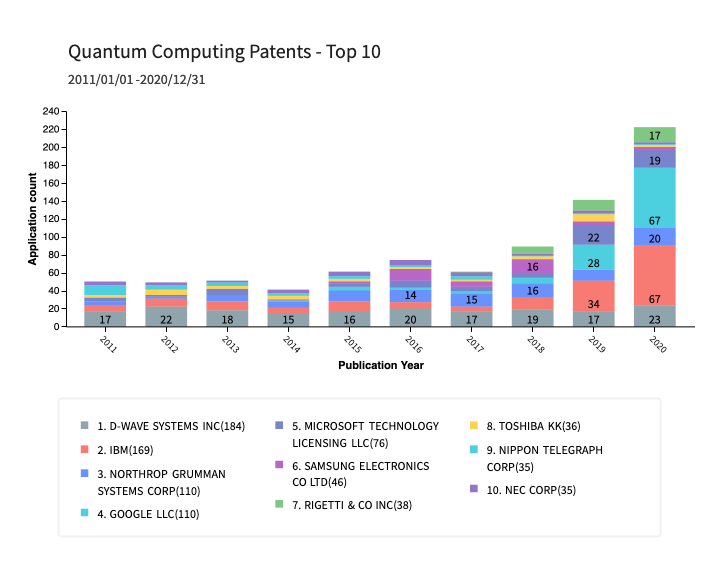
Fig. 1
Figure 2 shows results of the same search as in figure 1 but for all entities with quantum computing patents. Patent recipients with fewer patents than the top 19 are grouped together in an “Other” category. As a group, Other has collectively received more than half of the total number of patents since 2012, indicating the diverse sources of innovation in quantum computing. There is precedent to expect that some of the companies that end up being leaders in years to come will be among those Others of today. Among the top 19 recipients of patents for quantum computing technologies most are for profit corporations. However, one entity is an individual, Geordie Rose, who is the co-founder of D-Wave, and another, Newsouth Innovation Pty Ltd, is affiliated with the University of New South Wales in Australia.
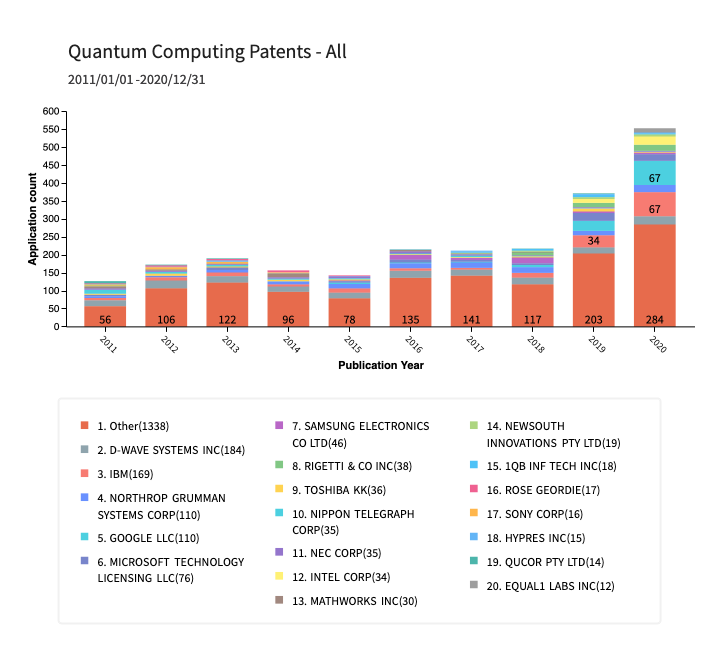
Fig. 2
Figure 3 shows the top nine patent offices by number of quantum computing-related patent applications granted since 2011. “Other” represents the number of patent applications in all other patent offices worldwide. Note that these data are for the country in which the patent application is being filed, not the location of the entity that is filing the application. The United States has awarded almost half of the total patents, followed by China and Japan. This is a reflection of both the level of activity and the perception of where markets are likely to emerge.
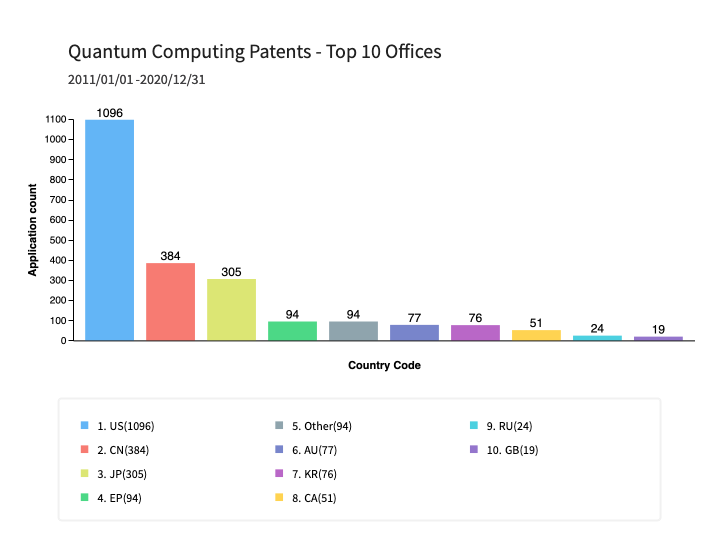
Fig. 3
Figures 4 and 5 show trends in PCT filings, which indicate interest in securing intellectual property protection in multiple countries and regions. Figure 4 shows the number of PCT patent applications related to quantum computing filed by the top 10 entities by publication year. Beginning in 2017, there is a strong upward trend in the total number of PCT applications published. Because there is an 18-month delay between filing and publication, the upward trend in filing these applications started in 2015. In addition to Newsouth Innovations, which is affiliated with the University of New South Wales, three other universities—MIT, Harvard and the University of Maryland—are among the top 19 PCT filers (Figure 5). As for U.S. patent recipients, we see that the Other category generally has the largest number of PCT applications, with the exception of a burst of applications filed by Intel that were published in 2018.
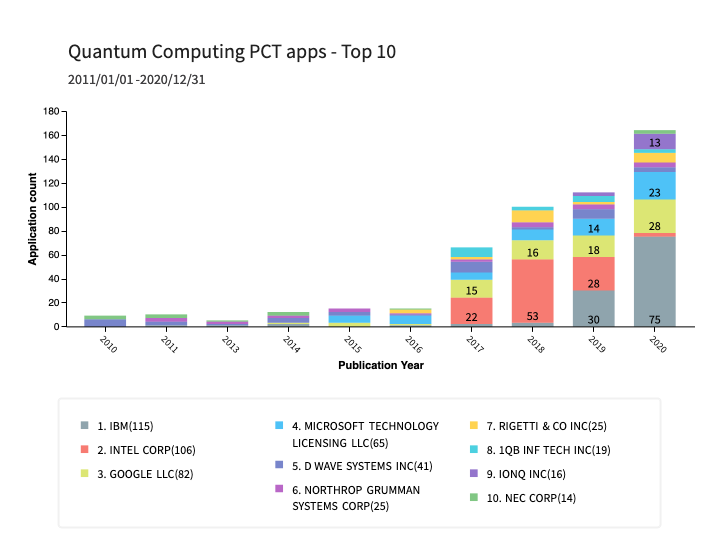
Fig. 4
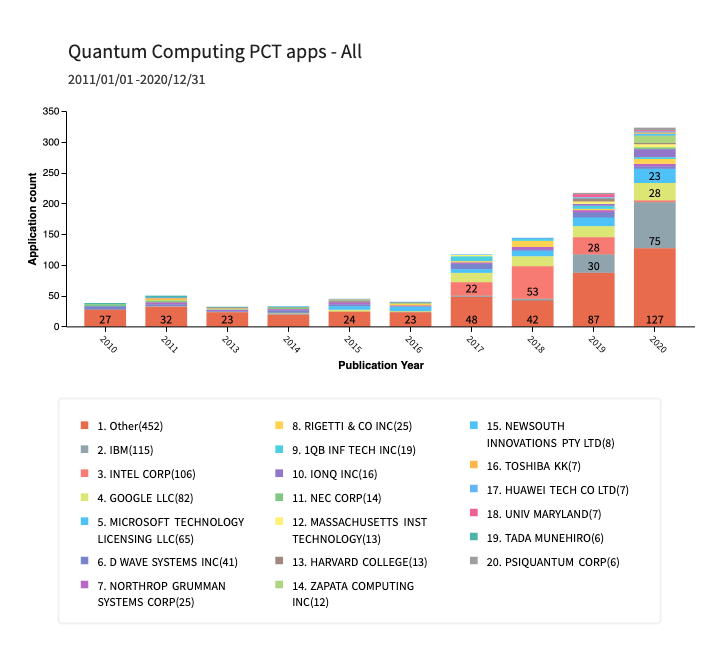
Fig. 5
Future posts will report patent data in quantum communications and potentially other areas. We also will track how quantum computing patent trends evolve with growing government investments and with reports of achievements by startups and small companies in the quantum computing hardware and software business.
Solution of the day
In this post, my pick for an interesting problem being solved, as revealed in a patent application that was recently published, is related to the sub-field of quantum optics. Future posts will sample a diverse mixture of sub-fields. Since this blog series will generally avoid revealing specific legal claims being pursued by any particular entity, the solution will be described in terms of the general problems being addressed.
One recently published quantum computing patent application provides solutions to problems related to timing in a photonic quantum computer. Precise timing is needed for certain operations in a quantum computer that uses qubits represented by entangled photon states in a photonic integrated circuit, for example. Using nonlinear optics to generate photon pairs from pump photons, pulses of unconverted pump photons can provide a clock signal, and one converted photon can be used to herald the arrival of the other converted photon for use as a qubit in a computation.
While I have kept the specific patent application anonymous in this post, interested readers may contact me for discussion on this or any other topic that is publicly disclosed and not client confidential (mason@youngbasile.com).
Elliott Mason is a patent agent at the law firm Young Basile, has a PhD in nonlinear and quantum optics, and was an experimentalist on a team at MIT working to demonstrate enabling technologies for long-distance quantum teleportation. The patent data are based on publicly available data hosted by Derwent Innovation. The views expressed in this blog entry are those of the author, and do not constitute a legal opinion and do not necessarily reflect the official policy or position of the QED-C, SRI International, or Young Basile. Any content provided is not intended to malign any country, ethnic group, company, organization, or individual.
+++++++++++++++
About QED-C: QED-C is an industry-driven consortium managed by SRI International that aims to enable and grow the quantum industry and associated supply chain. With more than 150 participants from industry, academia and government, QED-C connects stakeholders to speed quantum-based innovation and use. For membership information please contact admin@quantumconsortium.org.
This blog is an output of the QED-C Standards and Performance Metrics Technical Advisory Committee.
